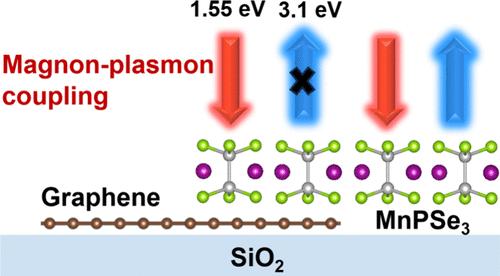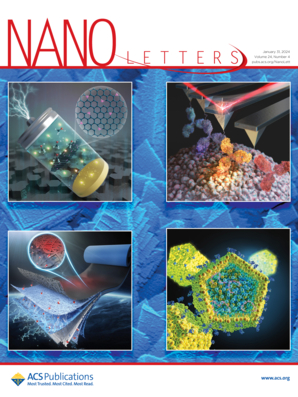MnPSe3/Graphene 异质结构中反铁磁体 MnPSe3 的非互惠二次谐波生成因界面磁子-普拉斯门耦合而受到抑制
IF 9.1
1区 材料科学
Q1 CHEMISTRY, MULTIDISCIPLINARY
引用次数: 0
摘要
界面耦合是利用磁性/非磁性二维(2D)异质结构实现新功能的关键之一。MnPSe3/ 石墨烯异质结构是量子信息和计量学的前瞻性平台。然而,人们对石墨烯如何通过界面耦合影响 MnPSe3 仍知之甚少。本文揭示了 MnPSe3/ 石墨烯异质结构中反铁磁体 MnPSe3 的二次谐波发生(SHG)。令人惊讶的是,研究发现当 MnPSe3 与石墨烯交界面时,低于 TN 的非互易或 c 型 SHG 消失了,这表明存在界面耦合和/或相互作用。最有趣的是,与短程界面邻近相互作用不同,这种界面相互作用可能是非接触式的长程相互作用,并且从二维金属/半导到绝缘底层都有不同。界面磁子-等离子体耦合可能在抑制 MnPSe3/ 石墨烯异质结构中 MnPSe3 的 c 型 SHG 信号方面发挥了重要作用。这项研究将加深我们对二维异质结构中非线性光学特性的理解。本文章由计算机程序翻译,如有差异,请以英文原文为准。

Suppressed Nonreciprocal Second-Harmonic Generation of Antiferromagnet MnPSe3 in the MnPSe3/Graphene Heterostructure Due to Interfacial Magnon–Plasmon Coupling
Interfacial coupling is one of the keys to manipulating magnetic/nonmagnetic two-dimensional (2D) heterostructures for novel functionalities. The MnPSe3/graphene heterostructure is a prospective platform for quantum information and metrology. However, how graphene affects MnPSe3 through interfacial coupling is still poorly understood. Herein, second-harmonic generation (SHG) of antiferromagnet MnPSe3 in the MnPSe3/graphene heterostructure is revealed. Surprisingly, it was found that below TN, nonreciprocal or c-type SHG of MnPSe3 disappeared when interfacing with the graphene, suggesting the existence of interfacial couplings and/or interactions. Most interestingly, different from the short-range interfacial proximity interaction, this interfacial interaction could be contactless and long-range and varied from 2D metallic/semiconducting to insulating underlayers. Interfacial magnon–plasmon coupling probably played an important role in suppressing the c-type SHG signals of MnPSe3 in the MnPSe3/graphene heterostructure. This study will improve our understanding of the manipulation of nonlinear optical properties in 2D heterostructures.
求助全文
通过发布文献求助,成功后即可免费获取论文全文。
去求助
来源期刊

Nano Letters
工程技术-材料科学:综合
CiteScore
16.80
自引率
2.80%
发文量
1182
审稿时长
1.4 months
期刊介绍:
Nano Letters serves as a dynamic platform for promptly disseminating original results in fundamental, applied, and emerging research across all facets of nanoscience and nanotechnology. A pivotal criterion for inclusion within Nano Letters is the convergence of at least two different areas or disciplines, ensuring a rich interdisciplinary scope. The journal is dedicated to fostering exploration in diverse areas, including:
- Experimental and theoretical findings on physical, chemical, and biological phenomena at the nanoscale
- Synthesis, characterization, and processing of organic, inorganic, polymer, and hybrid nanomaterials through physical, chemical, and biological methodologies
- Modeling and simulation of synthetic, assembly, and interaction processes
- Realization of integrated nanostructures and nano-engineered devices exhibiting advanced performance
- Applications of nanoscale materials in living and environmental systems
Nano Letters is committed to advancing and showcasing groundbreaking research that intersects various domains, fostering innovation and collaboration in the ever-evolving field of nanoscience and nanotechnology.
 求助内容:
求助内容: 应助结果提醒方式:
应助结果提醒方式:


